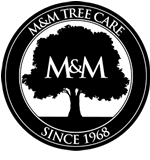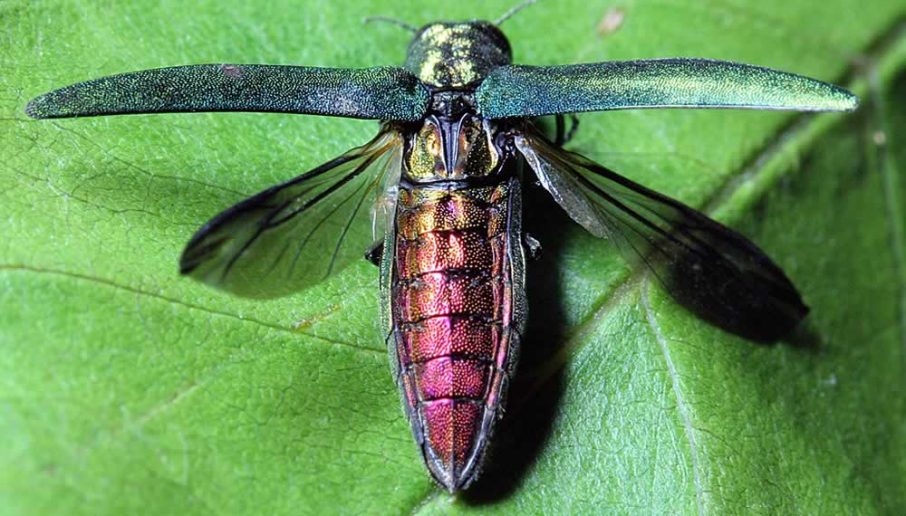What is the Emerald Ash Borer Invasive Species?
Emerald Ash Borer is an invasive insect native to Asia that started wreaking havoc on Ash trees in the Midwest in 2002. It was first sighted in Michigan. Today there 29 states with confirmed EAB infestation – including Wisconsin – and it has killed millions of trees nationwide. The tree care industry has come a long way since 2002 in understanding how the Emerald Ash Borer invasive species can be treated successfully with insecticide. This beetle is challenging to control because it does all of its damage under the bark and our Native American Ash trees have little natural resistance.
If you see any signs of EAB on your trees OR in your neighborhood, we encourage you to contact a professional arborist as soon as possible for a free inspection and evaluation of the damage.
Find Out For FREE if Your SE Wisconsin Trees Have EAB
Where did Emerald Ash Borer Come From?
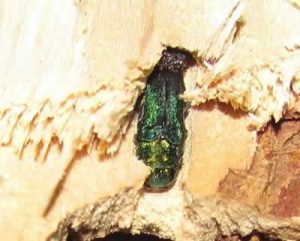 It was the summer of 2009 when I first recall hearing the scuttlebutt about the discovery of Emerald Ash Borer (EAB) in the municipality of Oak Creek, Wisconsin – although ground zero was Newberg, WI where EAB was first detected in the state of Wisconsin late Summer of 2008. The location in Oak Creek was off the 94 freeway stretch running from Chicago to Milwaukee. Arborists had the theory that EAB was transported on a truck running freight from the Illinois area up to central Wisconsin. It probably arrived in the United States on solid wood packing material carried in cargo ships or airplanes originating in its native Asia. Regardless of how it arrived, the bottom line is that today ALL of the SE Wisconsin counties have detected EAB – and the destructive pest is not going away anytime soon. So if you are located in metro Milwaukee counties including Waukesha, Washington, Ozaukee, Racine or Kenosha – be on the lookout for Emerald Ash Borer!
It was the summer of 2009 when I first recall hearing the scuttlebutt about the discovery of Emerald Ash Borer (EAB) in the municipality of Oak Creek, Wisconsin – although ground zero was Newberg, WI where EAB was first detected in the state of Wisconsin late Summer of 2008. The location in Oak Creek was off the 94 freeway stretch running from Chicago to Milwaukee. Arborists had the theory that EAB was transported on a truck running freight from the Illinois area up to central Wisconsin. It probably arrived in the United States on solid wood packing material carried in cargo ships or airplanes originating in its native Asia. Regardless of how it arrived, the bottom line is that today ALL of the SE Wisconsin counties have detected EAB – and the destructive pest is not going away anytime soon. So if you are located in metro Milwaukee counties including Waukesha, Washington, Ozaukee, Racine or Kenosha – be on the lookout for Emerald Ash Borer!
Emerald Ash Borer Treatment
At M&M Tree Care, trunk injections are our preferred method for controlling EAB. Over the years, we have found it to be most effective Emerald Ash Borer treatment available. Emectin Benzoate is the active ingredient which acts systemically within the tree. This means the insecticide is transported from inside the tree. The trees vascular system has to be healthy enough to carry the insecticide up the trunk and into the branches and canopy. That’s why it’s helpful to get a certified arborist to inspect your tree before paying for treatment.
I believe it is not worth treating a tree if the more than 30% of the infected tree’s canopy is already dead. It’s best to treat Ash trees early while they are still healthy. As I like to say “It is a lot easier to maintain a healthy tree with a preventative pest management program than it is to save a tree that has already been infested.”
Other things to keep in mind when considering Emerald Ash Borer treatment are the age of the tree. Is it still young and healthy enough to transport the insecticide through its vascular system? Are there many other infected Ash trees nearby or is this an isolated incident? Do you plan to keep this property for years to come? And most importantly, do you enjoy this tree?
How does Emerald Ash Borer Damage Trees?
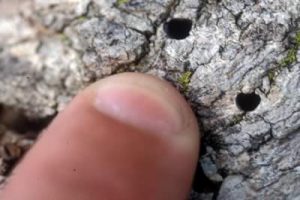 Emerald Ash Borer damages trees by tunneling underneath the bark of the tree and laying eggs (larvae). A close inspection can sometimes reveal a “D” shaped hole in bark where EAB enters. Then the larvae hatches and feeds in galleries under the bark. It looks like trails when bark is removed. This compromises the phloem and xylem tissue that all plants use to transport nutrients and water. As more and more larvae feed, the galleries interfere with the ability to transport not only nutrients, but also insecticide. That’s why it’s difficult to treat a tree that has advanced EAB infestation. Die back of an infested tree will be obvious as fewer leaves can be supported. Ultimately large branches will be girdled and killed by the larval galleries.
Emerald Ash Borer damages trees by tunneling underneath the bark of the tree and laying eggs (larvae). A close inspection can sometimes reveal a “D” shaped hole in bark where EAB enters. Then the larvae hatches and feeds in galleries under the bark. It looks like trails when bark is removed. This compromises the phloem and xylem tissue that all plants use to transport nutrients and water. As more and more larvae feed, the galleries interfere with the ability to transport not only nutrients, but also insecticide. That’s why it’s difficult to treat a tree that has advanced EAB infestation. Die back of an infested tree will be obvious as fewer leaves can be supported. Ultimately large branches will be girdled and killed by the larval galleries.
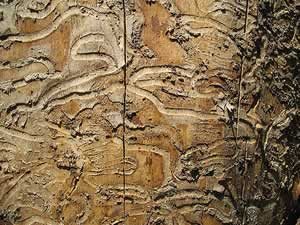 Specific signs of Emerald Ash Borer Damage are:
Specific signs of Emerald Ash Borer Damage are:
- thinning of the canopy
- water sprouts ( many green shoots ) on the lower trunk
- heavy wood pecker activity indicated by flecking of the bark
- vertical splits in the tree’s bark
- S-shaped channels under the bark
- Most importantly: distinct D-shaped exit holes. These holes are approximately 1/8” wide and can be oriented in any direction we consider this sign the strongest indicator of EAB.
It can be very difficult identifying Ash trees that only have a few larvae as there will be few to no external symptoms of infestation. However, after years of treating EAB personally, I do know this: most female EAB lay their eggs on nearby trees within 100 yards of the tree with which they have emerged.
“If your property is within 10-15 miles of a known EAB infestation in Wisconsin, your trees are at great risk.”ISA Certified Arborist, Rich Mathey
Systemic insecticide trunk injections should be done when the Ash trees have just leafed out. Studies have shown that peak Emerald Ash Borer egg hatch and larval establishment occur from June to August. It takes one to two weeks for the systemic insecticide to travel its way through the entire tree.
What Does an Ash Tree Look Like?
How do you know if you have any Ash trees on your property? After all, there are several species of Ash trees and it’s common to mistakenly think common deciduous trees are Ash like Elm, Boxelder, Mountain Ash, Walnut and Hickory. The best way to know for sure is to have an arborist like myself or one of the team members from M&M Tree Care take a look at your trees and give you a free evaluation. However, if you want to try and narrow it down yourself, there are some common attributes to look for when trying to identify an Ash tree that’s susceptible to EAB infestation.
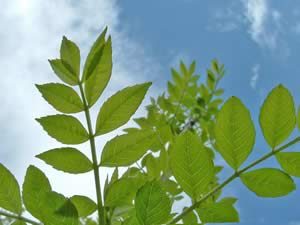 Leaves and branches that are directly across from one another (called “opposite branching” versus “alternate branching”).
Leaves and branches that are directly across from one another (called “opposite branching” versus “alternate branching”).- Multiple leaves attached to a single leaf stem (called a “compound” leaf).
- Diamond-like pattern on older Ash tree bark.
Since Ash trees are a “species” of tree, and not just a specific tree type, it can be difficult to determine if your tree is at risk. For example, Mountain Ash trees are not a true Ash species of tree so they are not at risk of Emerald Ash Borer damage. Commonly affected Ash species of trees at risk from EAB include:
- White Ash Trees – Typically found in Wisconsin forests up north and in Central Wisconsin hardwood forests. It has white, strong and straight-grained wood and is considered the most commercially important ash tree in Wisconsin.
- Green Ash Trees – Most common in Southern Wisconsin near river banks, flood plains and swamps. Not as straight as White Ash. Typically not desirable for commercial use.
- Black Ash Trees – Found all around Wisconsin, but most common in Northern Wisconsin. Often found in wet areas (often found with Green Ash).
- Blue Ash Trees – Found in Southern Wisconsin but not abundant. Smaller than other Ash species. Listed as state threatened species in Wisconsin. Grows best in rich limestone hills and in fertile bottomlands.
Emerald Ash Borer Prevention
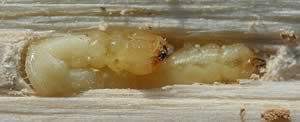 Even though EAB is a wide spread problem in SE Wisconsin and many trees are past saving, it’s still important to think about how to slow down the spreading of EAB and Emerald Ash Borer Prevention. It is still very important to follow the quarantine rules and to limit movement of Ash wood. The borer is here to stay for the foreseeable future but we can take the necessary precautions to slow the spread of EAB to the Northern Forests.
Even though EAB is a wide spread problem in SE Wisconsin and many trees are past saving, it’s still important to think about how to slow down the spreading of EAB and Emerald Ash Borer Prevention. It is still very important to follow the quarantine rules and to limit movement of Ash wood. The borer is here to stay for the foreseeable future but we can take the necessary precautions to slow the spread of EAB to the Northern Forests.
Replacement Trees: Recommended Alternatives to Ash Trees
A big part of our job here at M&M Tree Care is tree removal. Unfortunately, with so many trees being infested by EAB, we’ve been contracted by municipalities as well as property owners to do mass removals of Emerald Ash Borer damaged trees. For example, we are contracted to remove and replace about 500 trees in Cudahy alone this year.
So an important consideration is replacements for Ash trees. My advice is to use a variety of trees so you can minimize your impact if future diseases or insects become an issue.
Another thing to keep in minds is to select high quality nursery stock and most of the time paying discount rates for a tree doesn’t pay. Avoid buying stock that looks questionable. The crown should be well balanced, free of insects and diseases, turgid leaves (not wilted), healthy green color with no chlorosis or scorched or brown leaf margins. Trees should have straight, single, central leader, free from borer holes, damage, cracks, sunken or swollen areas (these could indicate disease). The tree’s trunk should have good taper and root flare near the base of tree. Trees should also have well-spaced and evenly distributed branches in the crown; avoid trees with very narrow branch crotches and included bark formation. Remember unacceptable trees will contain defects and substandard elements that cannot be easily corrected.
Many trees are harvested in the field from late March to right before budbreak in early May and again in late summer and fall from September to early November. However, some trees are only dug in spring due to poor transplant survival if dug from the field in late summer to fall. Here is a detailed list of recommendations on specific trees for SE Wisconsin Ash tree replacement:
*Acer ⋅ freemanii Freeman maple (hardy to zone 3b-4a, depends on cultivar)
Acer miyabei ʻMortonʼ State Street Miyabe maple (hardy to zone 4a)
Acer platanoides Norway maple (zone 4b), very invasive
*Acer rubrum Red maple (in acidic soils only!) (hardy to zone 3b-5b, depends on cultivar)
Acer ʻWarrenredʼ Pacific Sunset maple (hardy to zone 4b)
*Celtis occidentalis Common hackberry (hardy to zone 3b)
*Crataegus crus-galli var. inermis Thornless cockspur hawthorn (hardy to zone 4a)
Crataegus phaenopyrum Washington hawthorn (has thorns) (hardy to zone 4b)
Crataegus viridis ʻWinter Kingʼ Winter King hawthorn (very few if any thorns) (hardy to zone 4b)
Gymnocladus dioica Kentucky coffeetree (ʻEspressoʼ, ʻJ.C. McDanielʼ (Prairie Titan™ are males, no fruit) (hardy to zone 4a)
Phellodendron amurense ʻMachoʼ Macho Amur corktree (plant males only as females are invasive) (hardy to zone 3b)
Phellodendron lavallei ʻLongeneckerʼ Eyestopper• Lavalle corktree (male) (hardy to zone 4b)
Phellodendron sachalinense ʻHis Majestyʼ His Majesty Sakhalin corktree (male) (hardy to zone 3b)
*Quercus bicolor Swamp white oak (hardy to zone 4a)
Tilia tomentosa Silver linden (sensitive to road salt) (hardy to zone 4b)
*Ulmus americana American elm (DED resistant cultivars: ʻNew Harmonyʼ, ʻPrincetonʼ, ʻValley Forgeʼ) (hardy to zone 3a)
*Dig from ursery field in spring only
New Tree Care Tips
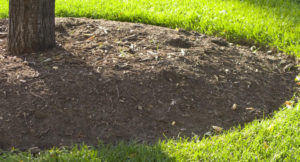 Once new trees have been planted, the aftercare is critical. Only stake a tree if necessary and if you do, use one or two wooden or metal stakes (4-5 ft tall) pounded into ground outside of the root ball into existing the soil. Use wide, flexible, fabric material to go around the lower half of the tree. Do not use rubber hose, wire or other material that can girdle the tree trunk – the tree should still be allowed to gently move.
Once new trees have been planted, the aftercare is critical. Only stake a tree if necessary and if you do, use one or two wooden or metal stakes (4-5 ft tall) pounded into ground outside of the root ball into existing the soil. Use wide, flexible, fabric material to go around the lower half of the tree. Do not use rubber hose, wire or other material that can girdle the tree trunk – the tree should still be allowed to gently move.
Water a newly planted tree daily for at least a week then every other day for 2 months. After that, water it weekly until it is established. “Establishment” of a tree is approximately 1 year for every 1 inch of tree caliper (trunk thickness). Continue to water into mid to late fall until the ground freezes. I recommend watering less frequently as temperatures decline in fall.
I highly recommend adding mulch to the planting area by using 2-4” of organic mulch (M&M sells organic mulch comprised of shredded bark, wood chips and shredded leaves.) to help retain soil moisture, moderate soil temperatures and reduce weed and grass competition. Perhaps most importantly – a nice ring of mulch at the base of your tree will keep weed wackers from wacking the bark of the lower trunk of your trees. Do not mulch high as this creates a mulch volcano and will kill the tree.
Get an Arborist’s Opinion
If you think you have Ash trees on your property or if you know your area is in danger, call one of our certified Arborists today! We will be able to help correctly identify your trees and make recommendations based on exactly what your trees might need. Contacting a Certified Arborist is the best way to assess the health of your trees. As I mentioned, there are several factors to consider like the size of the tree, health, location as well as its value to the landscape.
At M&M Tree Care, we understand the sentimental value of your trees and the intangible qualities trees provide. Removing a tree is not an easy decision and we want to help you make an informed decision, based on what is best for the health of your trees, your landscape and financial considerations. We can also help you decide on replacement trees that will meet your landscaping goals.
Contact us today for a free evaluation of your trees!
Share this Post
ABOUT THE AUTHOR
 Rich Mathey
Rich Mathey
Rich has been an ISA Certified Arborist since 2014 (Cert # WI-1084A) and since 2013 he has been a Plant Health Specialist at M&M Tree Care in Milwaukee. Rich is very experienced in Emerald Ash Borer facts and has treated EAB in SE Wisconsin as well as countless other tree insects and diseases. His favorite deciduous tree is Swamp White Oak and his favorite conifer is Sequoia or as John Muir liked to call it “Big Tree.”
